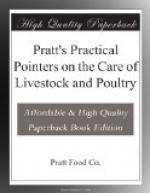-------------+
[Illustration: PRATTS PRACTICAL POINTERS]
As soon as the supply of pasture becomes insufficient in quantity or lacking in succulence, it should be supplemented with food cut and fed in the green form, as winter rye, oats and peas, and oats and vetches grown together, millet in several varieties, grasses, perennial and Italian rye, especially the latter, alfalfa, the medium red, the mammoth, alsike and crimson clovers, corn of many varieties, and the sorghums. Alfalfa, where it can be freely grown, is king among soiling foods. Peas and oats grown together are excellent, the bulk being peas. Corn is more commonly used, and in some sections sweet sorghum is given an important place. The aim should be to grow soiling foods that will be ready for feeding in that succession that will provide food through all the summer and autumn. Soiling furnished by grains, grasses, and clovers are usually fed in the stables or feed yards, and corn and sorghum are usually strewn over the pastures, as much as is needed from day to day.
Where much soiling food is wanted from year to year, it would seem safe to say that it can be most cheaply supplied in the form of silage. Even when grass is abundant, cows will eat with avidity more or less of ensilage well made. They should not be fed in winter more than 25 pounds per animal per day, but the quantity needed is determined largely by the condition of the pastures. Because of the less quantity of the silage called for in summer, the silo that contains the silage should be of less diameter than the silo that holds food for winter use, otherwise the exposed silage will dry out too much between the times of feeding it.
In autumn soiling foods may be fed with profit that are possessed of less succulence than would suffice at an earlier period, as in the autumn the pastures are usually more succulent than in the summer. Corn may be fed at such a time with much advantage from the shock, and sorghum that has been harvested may likewise be fed from the shock or from the cocks. Pumpkins may be thrown into the pasture and broken when fed.
Viewed from the standpoint of milk production, the legumes (clover, cow peas, soy beans, etc.) must be assigned first rank. After these come grain fodders, corn and sorghum fodders, and fodders from grasses, suitable in the order named. Lowest of all is straw furnished by the small cereals. Fodders when fed are not restricted in quantity as concentrates are.




